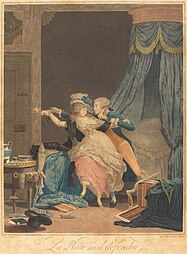You can help expand this article with text translated from the corresponding article in French. Click for important translation instructions.
|

Philibert-Louis Debucourt (13 February 1755 – 22 September 1832) was a French painter and engraver.
Life

Debucourt was born in Paris in 1755, and became a pupil of Joseph-Marie Vien. He executed a few plates in mezzotint, such as the Heureuse famille, the Benediction de la mariée, and the Cruche cassée, after his own designs. Most of his work was, however, in aquatint. He became the leading maker of multi-plate colour prints, combining washes of aquatint with line-engraving. He used a number of different techniques, but most involved three colour plates, and a fourth key plate, outlining the design in black.
Debucourt's father-in-law was the sculptor Louis-Philippe Mouchy. In the marriage contract Mouchy generously offered to provide a three-room apartment at the Louvre, where Debucourt lived for twelve and a half years. The address of this apartment is often given on his prints. Some of his work was satirical, such as La promenade publique, an aquatint of 1792 showing a crowd in the gardens the Palais-Royal. As well as work from his own designs, he made aquatints after Carle Vernet, including the Horse Frightened by a Lion, the Horse Frightened by Lightning and the Strayed Huntsman.
Debucourt was assisted for some years by his pupil and nephew, Jean-Pierre-Marie Jazet. He died at Belleville in 1832.
Seelected works
-
 The Poorly Defended Rose, intaglio (1791)
The Poorly Defended Rose, intaglio (1791)
-
 Celebrations given by the City of Paris at Les Halles, on the occasion of the birth of the dauphin
Celebrations given by the City of Paris at Les Halles, on the occasion of the birth of the dauphin
-
 The Public Promenade, etching, engraving, and aquatint (1792)
The Public Promenade, etching, engraving, and aquatint (1792)
-
 Promenade of the gallery of the Royal Palace, aquatint (1798)
Promenade of the gallery of the Royal Palace, aquatint (1798)
-
 The Compliment, or the morning of New Year's Day, aquatint (1787)
The Compliment, or the morning of New Year's Day, aquatint (1787)
References
- ^ Bryan 1886
- ^ "The public promenade". Art Gallery of New South Wales. Retrieved 22 October 2012.
- Griffiths, Antony (1996). Prints and Printmaking: An Introduction to the History and Techniques. University of California Press. p. 198. ISBN 9780520207141.
- Taws, Richard (2013). The Politics of the Provisional: Art and Ephemera in Revolutionary France. Penn State Press. p. 181. ISBN 978-0-271-06189-4. Retrieved 1 July 2014.
Sources
 This article incorporates text from a publication now in the public domain: Bryan, Michael (1886). "Bucourt, Philibert Louis de". In Graves, Robert Edmund (ed.). Bryan's Dictionary of Painters and Engravers (A–K). Vol. I (3rd ed.). London: George Bell & Sons.
This article incorporates text from a publication now in the public domain: Bryan, Michael (1886). "Bucourt, Philibert Louis de". In Graves, Robert Edmund (ed.). Bryan's Dictionary of Painters and Engravers (A–K). Vol. I (3rd ed.). London: George Bell & Sons.
External links
[REDACTED] Media related to Philibert-Louis Debucourt at Wikimedia Commons
- Prints & People: A Social History of Printed Pictures, an exhibition catalog from The Metropolitan Museum of Art (fully available online as PDF), which contains material on Philibert-Louis Debucourt (see index)
- Prints by Debourcourt in the British Museum
This article about a French painter born in the 18th century is a stub. You can help Misplaced Pages by expanding it. |
This article about a French artist is a stub. You can help Misplaced Pages by expanding it. |